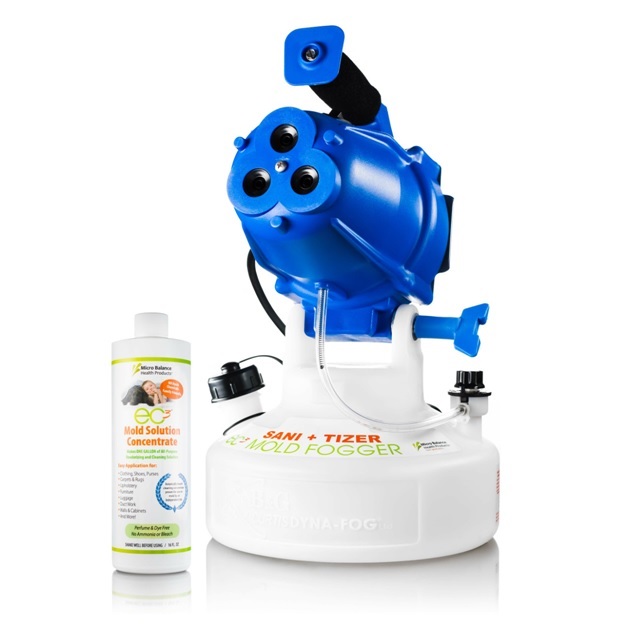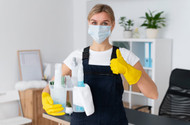Mythbusters: Debunking Common Misconceptions About Mold and Mold Removal
Jun 26th 2024
Have you noticed a persistent musty odor in your basement, or dark spots creeping up your bathroom walls? These could be signs of a mold problem.
Don't panic! In this article, we’ll guide you to a better understanding of mold. We’ll separate fact from fiction, explore the health risks associated with mold exposure, and provide clear steps you can take to address mold growth effectively.
Learn how to choose the safest and most effective solutions for your specific situation, ensuring a healthy home environment for you and your family.
Is Bleach the Ultimate Mold Killer? (Not Quite)
Bleach is a popular cleaning agent, often touted as a magic bullet for mold removal. While bleach can be useful for stain removal, it's not a foolproof solution for mold. Here's why:
- Limited Reach: Bleach only affects microbes on the surface, leaving behind deeply rooted mold colonies unharmed.
- Material Damage: Bleach can damage certain materials like fabrics and carpets, requiring replacement.
- Safety Concerns: Bleach fumes can irritate the lungs and eyes, especially in poorly ventilated spaces. Using a mold spray with a safer, chemical-free formula can be a better option.
For effective mold removal, consider using a mold sprayer or fogger with a solution that is specifically designed to target and eliminate mold colonies. These natural solutions often contain powerful yet safer ingredients that penetrate deeper and kill mold at its source. They are also less likely to create resistant fungi and bacteria that resist many commonly used disinfectants.
Does All Mold Require Professional Removal? (Not Always)
The severity of the mold infestation determines whether you can tackle it yourself. Small mold patches (less than 10 square feet) on non-porous surfaces (like tile or glass) can often be addressed with a good mold sprayer, effective products, proper cleaning techniques, and good ventilation.
However, extensive mold growth, mold on porous surfaces (like drywall), mold growth after a flooding situation, or the presence of black mold (a particularly dangerous type) all warrant professional intervention. Professionals have the expertise and equipment to safely remove large-scale mold infestations and prevent their return. When in doubt, err on the side of caution and consult a mold remediation specialist.
Can I Simply Paint Over Mold? (Absolutely Not!)
Painting over mold seems like a quick fix, but it's a recipe for disaster. Mold spores can easily penetrate paint, continuing to grow underneath the surface and potentially causing further damage. Furthermore, painting traps moisture, creating a perfect environment for mold to thrive.
The proper approach involves removing the mold completely before repainting. This might involve cutting out drywall or removing building materials prior to cleaning using a mold-targeted product in a mold sprayer, and scrubbing the affected area. Once the mold is gone, the area can be repaired and repainted, possibly with a mold-resistant paint to prevent future growth.
Does Cold Weather Kill Mold? (Wishful Thinking!)
While cold temperatures can slow down mold growth, they don't eliminate it entirely. Mold spores can remain dormant in cold weather, only to spring back to life when conditions become more favorable. The key to tackling mold is addressing the root cause – moisture.
If you suspect a mold problem in your home, don't wait for winter to "kill" it. Take action by identifying and addressing any moisture issues, such as leaky pipes or poor ventilation. Use a targeted mold product in a mold sprayer or fogger as needed and consider consulting a professional for comprehensive mold removal and prevention strategies.
Living with Mold is Inevitable – Fact or Fiction? (Definitely Fiction!)
Mold spores are present almost everywhere in the environment. However, a healthy home environment with proper ventilation and controlled moisture levels minimizes the risk of mold growth. Here are some simple steps you can take to prevent mold in your home:
- Fix leaky faucets and pipes promptly.
- Maintain good ventilation in your bathroom and kitchen.
- Clean up spills and damp areas immediately.
- Use dehumidifiers in basements and other moisture-prone areas.
- Inspect your home regularly for signs of mold growth.
By taking proactive steps and dispelling common myths, you can create a mold-free environment for a healthier and happier home.
Taking Control of Mold with the EC3 Sanitizer Fogger and Mold Solution Concentrate Bundle
While professional mold remediation is crucial for extensive infestations, the EC3 Sanitizer Fogger and Mold Solution Concentrate Bundle offers powerful tools for tackling mold growth and improving indoor air quality.

The EC3 Mold Solution Concentrate is the heart of this bundle. This eco-friendly formula utilizes a proprietary blend of ingredients designed to target and eliminate mold spores. Unlike harsh chemicals, the EC3 solution is people- and pet-safe, free from harmful fumes or toxic residues.
Benefits of Fogging with EC3
Fogging with the EC3 Sanitizer Fogger delivers several benefits:
- Effective Mold Control: The fogging process ensures the EC3 solution reaches even hidden corners and crevices, effectively eliminating mold spores and preventing their return.
- Improved Air Quality: The EC3 solution not only tackles mold but also deodorizes your indoor space, creating fresher and healthier air for you and your family.
- Safe for Routine Maintenance: For individuals with mold sensitivities, regular fogging with EC3 can significantly improve indoor air quality and reduce allergy triggers.
- Safe for Most Surfaces: The EC3 solution is safe to use on a variety of surfaces and fabrics, making it a versatile tool for tackling mold in different areas of your home.
How to Use the EC3 Fogger for Optimal Results
Using the EC3 Fogger is a simple process:
- Dilute the EC3 Mold Solution Concentrate: Follow the instructions on the bottle to properly dilute the concentrate with distilled water.
- Fill the Fogger Drum: Carefully pour the diluted solution into the fogger drum.
- Set the Spray Volume: Use the calibration dial to select the appropriate spray volume for the size of the room or object you're treating.
- Fog the Space: Turn on the fogger and hold the handle directing the mist in a steady up-and-down motion to ensure it fills the entire room or covers the targeted surface. You just want a thin mist to cover walls, ceilings, floor, and any objects in the room. The mist should easily dry completely within 5 minutes. Do not saturate anything with the mist.
- Clean Up: Once finished fogging, turn off the fogger and drain any remaining solution. Clean the fogger drum for future use.
Important Note: While the EC3 fogger is a valuable tool, it's not a substitute for professional remediation for extensive mold growth. If you suspect a serious mold infestation, consult a professional for a complete assessment and remediation plan.
Breathing Easy in a Mold-Free Home
Mold doesn't have to be a source of stress and anxiety. Armed with accurate information and the right tools, you can tackle mold growth effectively and create a safe and healthy environment for yourself and your loved ones.
At Micro Balance Health Products, we offer a variety of mold solutions, including safe and effective mold sprayers, to help you achieve a mold-free home.
Browse our selection online to find the right tools and take control of your indoor environment. Remember, a little knowledge goes a long way in keeping mold at bay and promoting a healthy home for all.



